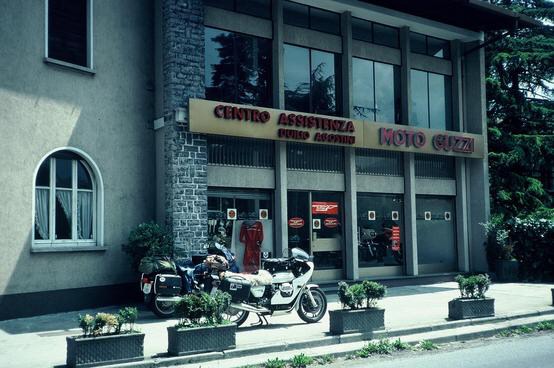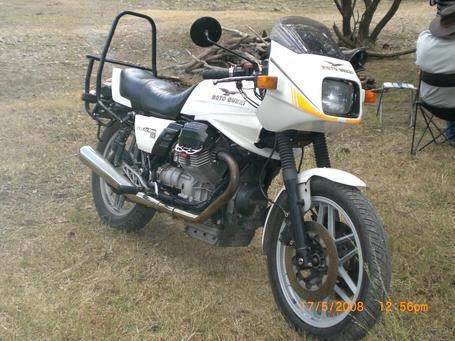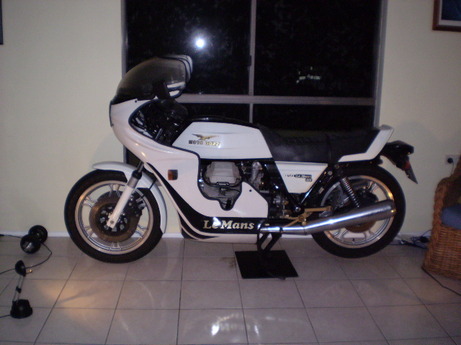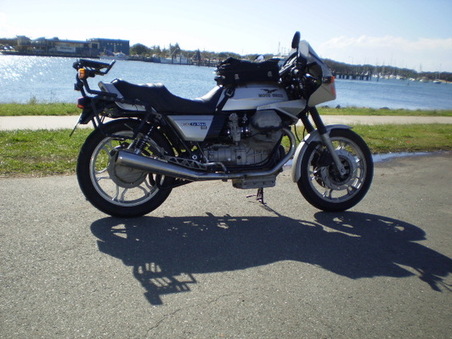Review: 850 Le Mans MK III
Moto Guzzi V7 Sport, 750 S, 750 S3, 850 T, 850 T3, 850 T3 California, V1000 I-Convert, V1000 G5, 1000 SP, Le Mans, Le Mans II, Le Mans CX 100, Le Mans III, Le Mans 1000, 1000 SP III, 1000 S, California II, California III, California 1100, California Jackal, California EV, California EV Touring, California Aluminium, California Titanium, California Special, California Special Sport, California Stone-Metal, California Stone-Touring, California Classic, California Touring, and California Vintage models
Created:
Updated:

Photo courtesy of Rod Yeomans.
I purchased my first MK III new in '83 from Agostinis. I had pre-ordered the bike for a European delivery and I was going to ride it around for a couple of months before taking it back to Mandello where they would crate it up and ship it home for me. The Mk III was a bike in transition. It was the middle of the true Tonti Le Mans series, the last of the 850s but it was the first of the square fins yet it was immensely successful for Guzzi with nearly 10,000 sold. It had striking angular lines, a formidable heritage from the original and MK II, and the largest white tachometer dominating the dash that I had ever seen on a motorbike. It has been written that many of the sales were due to that tacho. It's a Tonti frame big block and shares many components with other models of that era. Frame, electrics, brake system, wheels, drive shaft were virtually the same as many of the naked touring (T) or faired (SP) bikes yet there is enough to stand it apart. Many of the comments in this piece are therefore relevant to all Tontis, not just the MK III. It differed from its predecessors in a number of ways besides looks. The square fin motor not only looked more modern but it had more fin area for cooling but more importantly it produced a claimed 5 more hp. There was no real change to internal design but Guzzi had just improved machining tolerances with the new engine. (Mick Walker) The bores were now lined with Guzzi's patented Nigasil lining to reduce wear from earlier chrome and iron liners, though a few of the later LM II's had this lining too but not the majority. The rings required for this differ from earlier rings of the same size so take care if purchasing replacements. For handling the swing arm was a bit longer giving it a bit more high-speed stability and the solid rubber seat didn't fall apart even though it didn't provide any more comfort.

Photo courtesy of Rod Yeomans.
The MK III engine is considered by some as one of the best engines ever to be produced by Guzzi. It's a mid valver with good compression. The valves are big enough to breathe but not too big to cause excessive wear and the PHF 36 lean burn pumper carbs give the bike enough fuel when it's needed. In fact care needs to be taken at lower revs not to twist the throttle too quickly providing too much fuel for the start of acceleration. At 4000 RPM the engine is as smooth as a multi. It has another harmonic at 6000 RPM but red line at 7700 prevents the next one at 8000 RPM. Other sized Guzzi models that I have ridden don't seem to have this level of balance within the mill. Due to the changing crankcase volume Guzzi twins use a breather system. Instead of using an expansion chamber as in earlier models the MKIII used the bikes frame for this purpose and to return oil mist condensate to the sump. The breather ports in the heads or rocker covers of other models were dispensed with too. I have read how the lack of breathing here can cause moisture condensate to build up under the rocker covers but I have only ever experienced this once, after a 1600 km ride in torrential rain. The sump oil wasn't affected but there was a smear of emulsified oil that could just be detected. It had been such a wet trip that I had breathed so much spray from passing vehicles that I had developed a persistent cough to try and clear my lungs, so I couldn't blame the bike for inhaling moisture too in those conditions. I have no plans to try and modify the system as it was such a small issue after what was an exceptional weather event. I was just lucky to make it home due to the extensive flooding. The bike was originally fitted with twin points but most riders have fitted electronic ignition. I still have my original MK III with points but my second has electronic optical pick-ups. The timing chain adjuster, like all big blocks of the time was basic to say the least. An after market spring tensioner improves things dramatically. My original bike is fitted with steel timing gears from Agostinis. Beware of after market or alloy gears. They have a nasty habit of chewing themselves to pieces but the originals, like mine are virtually impossible to obtain. The alloy isn't magnetic, of course, so their demise may come as a surprise. There were 2 gearbox options. The standard T helical box or the close ratio, straight cut ZD box. I had the option for either, the ZD being more expensive but I chose the standard box for one very good reason. The last thing this bike needs is a higher first gear and that's what you got with the ZD. It also produced a real whine as most straight cut gears do. The ZD is now difficult to find and new parts are made of unobtanium. There were more than one close ratio set so this probably makes finding the right part even harder. The flywheel is heavy and I like it that way. A firm foot movement and a bit of patience on the up change and a blip of throttle on the down change assists a smooth selection. I remember vividly my first test ride at a dealer's in Australia. I had ridden there on a 16 valve Honda 750. The Guzzi burst into life with all the subtlety of a massive tractor and it would throw itself into my right leg every time I twisted the throttle even slightly due to the flywheel and torque reaction. The ride held the same surprises with the seat rising as I eased out the clutch due to the shaft forcing the rear wheel into the road and the bike balancing itself with the torque reaction on every gear change. Its been a long time since then and my senses no longer acknowledge these forces. Its sad in a way but I have just become accustomed to it as a part of the experience. I often read of a new owner wishing to lighten the flywheel and I wonder if they realise the proportional increase of power pulse along the shaft and rear drive. I've never read or heard of anyone proposing going down the lightened flywheel route even considering servicing the cush drive or replacing the aging rubbers enclosed in the rear wheel so I can only deduce they don't realise at all. Another part of the bike that often is forgotten and neglected is the drive shaft and universal joint. The splines can do with some grease periodically and the u-joint should be inspected for wear or signs of failure. This isn't quite so critical as in other later models. The rear drive doesn't have a breather but there is no seal between it and the swing arm so some oil travels up and helps to lubricate the lower half. The output shaft doesn't have the extra o-ring fitted to later models either so a small amount of oil usually seeps out between the shaft and the speedo worm drive lubricating the u-joint. It doesn't completely negate the need for a grease but every little bit helps. The PHF 36 carbs are fitted with bell tops. This allows a faster throttle response but increases throttle resistance. Some find the action too hard so remove the bell tops and fit flat tops and new cables. Another option is fitting a throttle lock or palm rocker to alleviate the pressure and allow some rest. I'm accustomed to the action and really all riders need to do is to ride the bike and get used to it. For extra soft riders a couple of doses of medicinal harden up
wouldn't go astray. After all it's a Le Mans, not an automatic Piaggio scooter. The lean burn PHF's don't need to be jetted up very much unless you are a big fan of wasting fuel and in standard trim the bike can easily attain 5.5 L - 5.8 L/100 km. Too rich a mixture can create unburned fuel that can wash the bores that cause excess wear too. Given this and the 25 litre fuel tank it gives the bike a fantastic range of over 400 km so comfort tends to be the cause of most pit stops rather than necessity. A friend purchased a BMW R100RS at the same time as I purchased my original LM III. The bikes had similarities and we toured together through Europe. His bike with Bing carbs was just a fraction more economical than the Dellorto fed Guzzi. If we put in 18 or 19 litres then I would always put 0.1 or 0.2 litres more in. Proportionally there wasn't a lot in it. The linked brake system works well and the bike can be stopped hard in a straight line just using the foot lever.

Photo courtesy of Rod Yeomans.
Again I read about new owners who have always wanted a Guzzi but don't appreciate the linked system. I think the brakes are one of the things that make these bikes unique. They worked better than the standard arrangement with tests showing a reduction of stopping distances in the order of 25%. I am forced again to wonder why the new owner didn't just buy a BMW or Ducati. The bike came standard with snowflake
cast wheels and I've heard that some of the very late bikes came out with the later straight spoke versions. These were originally designed for tubed tyres but with a small modification for the valve stem they seem to cope with tubeless tyres quite well. This topic is keenly debated by those that think tubes are safer as that's what they were designed for. I purchased a second hand MK III a number of years ago. I got a slow puncture in the front tyre one day but I was able to make it 40 km to the next town with the last few hundred metres to the garage with it totally flat. I still needed a bead breaker to get the tyre off and to my surprise there wasn't a tube. I've run it like that ever since as it means I can carry a plug kit as an emergency repair. Air can be a bit of a problem in the tyres. Most air fittings available at a garage won't fit in between the 300 mm front discs and the rim but an angled adapter overcomes this issue. The rear drive and 260 mm rear disc achieve the same result on the rear. I run recommended trye profiles on my bikes. I find that they handle very well and the stable steering geometry really doesn't need wider tyres to slow the change of direction. Any profiles much wider or higher wouldn't fit anyway. The front wouldn't fit between the guard retaining bolts and the swing arm doesn't have the indented shape of later models to allow a wider rear. If a 120/90/18 is fitted to the rear it will fit but it means that the tyre will touch the ground whilst the bike is sitting on the centre stand. This can cause some stability issues on uneven ground and I wouldn't recommend anything taller. Original suspension looked good on paper. Air assisted front and back but the Paolis on the rear weren't the best quality and when they expired rebuild kits weren't available. There are quite a number of replacement options. I have had Marzocchis but I found them a bit stiff and prefer the Ikons that are currently fitted. There are more exotic, read expensive, options that are available too. The forks are only 35 mm and with the split front brake due to the linked system there is a noticeable twist when using the hand-operated brake. A fork brace alleviates this twist. One thing I have noticed with the 300 mm front discs is that it is the single disc that will warp if one is going to. I've had one do this and a number of other owners I have talked to have reported the same. I have wondered if it is this twist that creates the warp as I haven't had another issue since fitting the brace. If the recommended air pressure is inserted in the dampers for pre-load they tended to be too hard for the real world. Hit a bump in a corner and the damper would have trouble stopping the springs from rebounding. I now only put a few psi in them and find it an improvement. On the road the bike likes to be run. Open country with sweeping curves is its best domain. I've commuted on the bike but it's not really well suited. The forward lean limits visibility in traffic and with no wind resistance the weight on the arms and hands can become tiresome. The long wheelbase and steering geometry is suited to high-speed stability not wiggling in and out of traffic and the clip-ons limit the leverage for steering also. I have listened and read comments about the switches, how they are unreliable and tend to break. Both of my MK III's still have their original switches and they all work. To add to this my '81 Monza has identical controls and they work too. They are different to most of the Japanese style switches of that era too but once you are accustomed to them they are no more difficult.

Photo courtesy of Rod Yeomans.
I have my second MK III set up for touring. Non-Fango racks and bags fit easily on the Tonti frame just as they would on one of the touring models. A Corbin seat, that is no longer available, really improves the rear end comfort and a set of flatter bars looks after the arms and wrists. The bars are easily fitted as the top steering yoke still came with the bar saddle hidden under the rubber dash. A couple of clamps from the wreckers, four bolts and the job's done. The side stand on the bike tends to lean it dangerously over especially if you ride on the left side of the road. When parking the bike it leans down into the gutter rather than up into the camber as it would in Italy. It can't be lowered from the saddle either but again there are options to improve matters. I have modified the stand bracket so that I can lower the stand whilst astride the bike and lengthened it so it doesn't lean as far. This helps when loaded with gear and weary after 4 hours riding due to that 400 km range. I simply lower the stand then once dismounted I can deploy the centre stand, negating the need for the one legged balancing act. I have also read and know owners who have fitted the side stand from a GPZ 750. It mounts onto the bracket for the centre stand and requires only one hole to be drilled. A stable center stand is fitted which allows nearly all maintenance. I certainly wouldn't buy a bike without one. I remember the mechanics at Agostinis pushing the bikes sideways out of their way with their hips and the bikes never faltered. All in all I can say the MK III is a reliable every day classic. With only minor alterations it can be the basis of a comfortable tourer or it can still surprise many with its handling and performance in sport mode. Oh, and they can still attract a bit of attention if your ego ever needs a boost.
Moto Guzzi 850 Le Mans III Technical specifications
| Year | 1981-1984 |
|---|---|
| Bore (mm) | 83 |
| Stroke (mm) | 78 |
| Capacity (cc) | 844.057 |
| Compression (:1) | 9.8 |
| Valve type | ohv |
| bhp | 76 (crankshaft) |
| @ RPM | 7700 |
| Torque (Kg-m) | 7.6 |
| @ RPM | 6200 |
| Starting system | Electric |
| Oil system | Wet sump |
| Valve timing | ohv |
| Inlet opens BTDC | 20 |
| Inlet closes ATDC | 52 |
| Transfer exhaust open BBDC | 52 |
| Exhaust closes ATDC | 20 |
| Tappets, inlet (mm) | 0.22 |
| Tappets, exhaust (mm) | 0.22 |
| Primary drive gearing | 1.235 |
| Final drive gearing | 4.714 |
| Box gearing: 5th | 0.750 |
| Box gearing: 4th | 0.869 |
| Box gearing: 3rd | 1.047 |
| Box gearing: 2nd | 1.388 |
| Box gearing: 1st | 2.000 |
| No. gears | 5 |
| Front tyre | 100/90 V18 |
| Rear tyre | 110/90 V18 |
| Front brake (mm) | d/disc 300 |
| Rear brake (mm) | disc 242 |
| Front suspension | telescopic |
| Rear suspension | swingarm |
| Ignition system | coil |
| Wheelbase (mm) | 1505 |
| Ground clear, (mm) | 175 |
| Width (mm) | 640 |
| Length (mm) | 2190 |
| Dry weight (kg) | 206 |
Carburetor settings:
| Dell'Orto type | Size | Main | Pilot | Slide | Needle | Needle Position | Needle Jet |
|---|---|---|---|---|---|---|---|
| PHF 36BS/BD | 36 | 115 | 50 | 603 | K18 | 3 | 265AB |